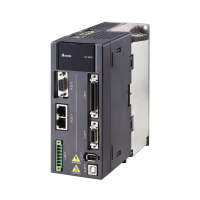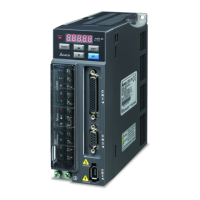Chapter 6 Applied Instructions
6-495
API Instruction code
Operand
Function
2120 FMOD P
S
1
, S
2
, D
Converting the floating-point
number into the binary-coded
decimal floating-point number
Device
X Y M S T C HC D L SM SR E PR K 16# “$” DF
Pulse instruction 32-bit instruction (7-8 steps) 64-bit instruction
AH500 AH500 -
Symbol:
S
1
:
Floating-point number Double word
S
2
:
Number of places Word
D
:
Conversion result Word
Explanation:
1. The decimal point in the floating-point number in S
1
is moved to the right in accordance with
the setting of S
2
first, and then the result is converted into the binary-coded decimal
floating-point number. The final conversion result is stored in D.
S1
Floating-point number
Number of places
S1
S2
D
D
D
D
D
+1
+2
+1
+3
+4
Sign
Seven-digit
binary-coded
decimal number
Sign (Exponent)
Exponent
Binary-coded decimal
floating-point number
The binary-coded decimal floating-point number format:
S
2
: The number of places
The value in S
2
should be within the range between 0 and 7.
D: If the floating-point number in S
1
is a positive number, the value in D is 0. If the floating-point
number in S
1
is a negative number, the value in D is 1.
(D+2, D+1): The seven-digit binary-coded decimal number converted from the floating-point
number
D+3: If the exponent is a positive number, the value in D+3 is 0. If the exponent is a negative
number, the value in D+3 is 1.
D+4: The exponent
If the floating-point number in S
1
is -0.03225547 and the value in S
2
is 4, the conversion result
is as follows.
()
S1+1,S1
S2
D
D
D
D
D
+1
+2
+3
+4
0.03225547
4
1
16#3225550
1
4
Number of places
Since the value in S
2
is 4, the decimal point in the floating-point number in S
1
is moved to the
right by four decimal places. The floating-point number in S
1
becomes -322.5547.
-322.5547 is equal to -3225547E-4. The binary-coded decimal floating-point number format is

